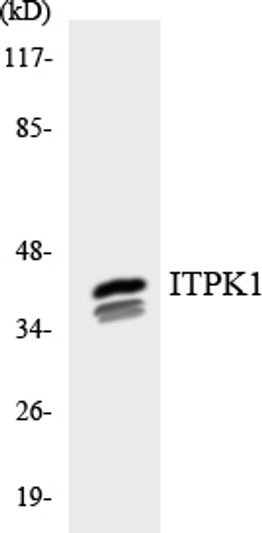| Host: | Rabbit |
| Applications: | WB/ELISA/IHC |
| Reactivity: | Human/Mouse |
| Note: | STRICTLY FOR FURTHER SCIENTIFIC RESEARCH USE ONLY (RUO). MUST NOT TO BE USED IN DIAGNOSTIC OR THERAPEUTIC APPLICATIONS. |
| Short Description : | Rabbit polyclonal antibody anti-Inositol-tetrakisphosphate 1-kinaseP3 5/6-kinase (81-130 aa) is suitable for use in Western Blot, ELISA and Immunohistochemistry research applications. |
| Clonality : | Polyclonal |
| Conjugation: | Unconjugated |
| Isotype: | IgG |
| Formulation: | Liquid in PBS containing 50% Glycerol, 0.5% BSA and 0.02% Sodium Azide. |
| Purification: | The antibody was affinity-purified from rabbit antiserum by affinity-chromatography using epitope-specific immunogen. |
| Concentration: | 1 mg/mL |
| Dilution Range: | WB 1:500-2000IHC-P 1:50-300ELISA 2000-20000 |
| Storage Instruction: | Store at-20°C for up to 1 year from the date of receipt, and avoid repeat freeze-thaw cycles. |
| Gene Symbol: | ITPK1 |
| Gene ID: | 3705 |
| Uniprot ID: | ITPK1_HUMAN |
| Immunogen Region: | 81-130 aa |
| Specificity: | ITPK1 Polyclonal Antibody detects endogenous levels of ITPK1 protein. |
| Immunogen: | The antiserum was produced against synthesized peptide derived from the human ITPK1 at the amino acid range 81-130 |
| Post Translational Modifications | Acetylation by EP300 and CREBBP destabilizes ITPK1, and down-regulates enzymatic activity. Deacetylated by SIRT1. |
| Function | Kinase that can phosphorylate various inositol polyphosphate such as Ins(3,4,5,6)P4 or Ins(1,3,4)P3. Phosphorylates Ins(3,4,5,6)P4 at position 1 to form Ins(1,3,4,5,6)P5. This reaction is thought to have regulatory importance, since Ins(3,4,5,6)P4 is an inhibitor of plasma membrane Ca(2+)-activated Cl(-) channels, while Ins(1,3,4,5,6)P5 is not. Also phosphorylates Ins(1,3,4)P3 on O-5 and O-6 to form Ins(1,3,4,6)P4, an essential molecule in the hexakisphosphate (InsP6) pathway. Also acts as an inositol polyphosphate phosphatase that dephosphorylates Ins(1,3,4,5)P4 and Ins(1,3,4,6)P4 to Ins(1,3,4)P3, and Ins(1,3,4,5,6)P5 to Ins(3,4,5,6)P4. May also act as an isomerase that interconverts the inositol tetrakisphosphate isomers Ins(1,3,4,5)P4 and Ins(1,3,4,6)P4 in the presence of ADP and magnesium. Probably acts as the rate-limiting enzyme of the InsP6 pathway. Modifies TNF-alpha-induced apoptosis by interfering with the activation of TNFRSF1A-associated death domain. Plays an important role in MLKL-mediated necroptosis. Produces highly phosphorylated inositol phosphates such as inositolhexakisphosphate (InsP6) which bind to MLKL mediating the release of an N-terminal auto-inhibitory region leading to its activation. Essential for activated phospho-MLKL to oligomerize and localize to the cell membrane during necroptosis. |
| Protein Name | Inositol-Tetrakisphosphate 1-KinaseInositol 1 -3 -4-Trisphosphate 5/6-KinaseInositol-Triphosphate 5/6-KinaseIns(1 -3 -4p(3 5/6-Kinase |
| Database Links | Reactome: R-HSA-1855167Reactome: R-HSA-1855204Reactome: R-HSA-983231 |
| Cellular Localisation | |
| Alternative Antibody Names | Anti-Inositol-Tetrakisphosphate 1-Kinase antibodyAnti-Inositol 1 -3 -4-Trisphosphate 5/6-Kinase antibodyAnti-Inositol-Triphosphate 5/6-Kinase antibodyAnti-Ins(1 -3 -4p(3 5/6-Kinase antibodyAnti-ITPK1 antibody |
Information sourced from Uniprot.org










